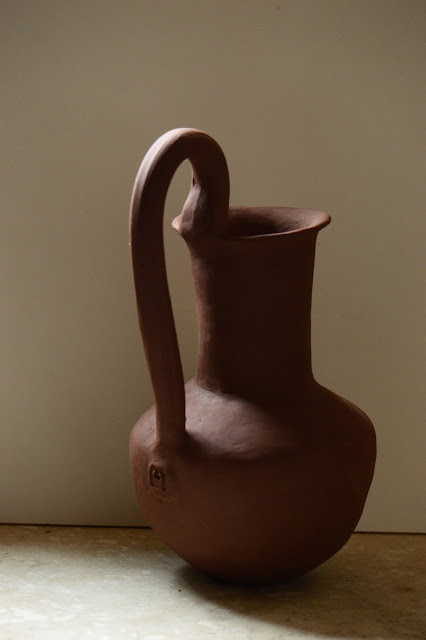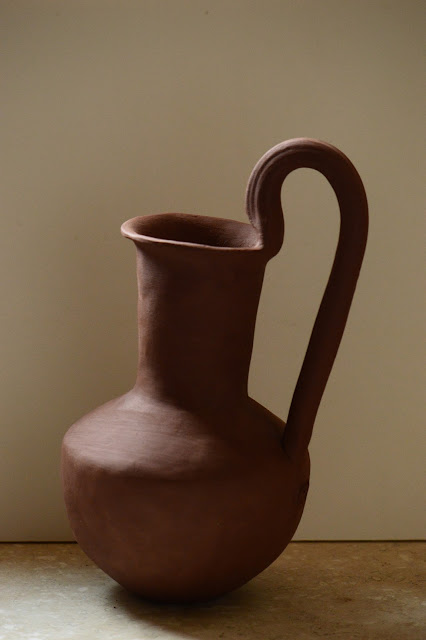Newly made, drying as slowly and evenly as I can manage, this is the most complex form that I have attempted in handbuilt pottery to date. It will need a bit more finish work, but that will wait until it is more or less completely dry. One process accident may have already fated this piece to remain a concept piece, as the handle was pulled slightly away during work. I've remedied this as well as I can, and I certainly hope the correction withstands the stresses of drying and firing. There will be more of these pots, whether or no. It was a very satisfying form to make.
Friday, January 8, 2016
Tuesday, January 5, 2016
Saturday, January 2, 2016
Glaze in the Making
The first full glaze test (and a small one, at that) is out of the kiln. While I have walked round and round the glaze options for the new earthenware clay, the slow thought has payed off in one respect, with a correctly melting and apparently usable glaze right from the first trial.
I say apparently because these tiles were fired in our tiny test kiln. With a much more rapid firing and cooldown, it cannot quite replicate the results of a regular ware fire. However, I am going to try #3 on some pieces soon. And then I will know a lot more. Probably!
This glaze makes use of ingredients from the region. Navajo pumice, mined in New Mexico, supplies both silica and alumina, two of the three main ingredients in most workable glazes. I have also used Gerstley borate, a calcium borate from Death Valley, California, an often maligned but often invaluable source of boron in glazes. It provides for a good, glassy melt and is probably the source of the bubbles in tiles #2, #3, and #4, though I can't say for sure yet. Also present is some baking soda as I needed sodium and was short on other sources! It is not normally used because it is soluble in the glaze batch; however, I decided it was worth a try, and I made my batch and used it immediately to avoid trouble.
I normally start my glaze calculations from the molecular formulae and then do line blends based on weight. So I will be able to substitute a different source of sodium once I get some more supplies, though there may be different results as few ingredients are quite as pure as chemical formulae... I have yet to analyze the mathematical results from this set, but look forward to doing that soon!
In the meantime, I am back at work with the clay after an enforced break over part of November and half of December. Cheers to the New Year!
I say apparently because these tiles were fired in our tiny test kiln. With a much more rapid firing and cooldown, it cannot quite replicate the results of a regular ware fire. However, I am going to try #3 on some pieces soon. And then I will know a lot more. Probably!
This glaze makes use of ingredients from the region. Navajo pumice, mined in New Mexico, supplies both silica and alumina, two of the three main ingredients in most workable glazes. I have also used Gerstley borate, a calcium borate from Death Valley, California, an often maligned but often invaluable source of boron in glazes. It provides for a good, glassy melt and is probably the source of the bubbles in tiles #2, #3, and #4, though I can't say for sure yet. Also present is some baking soda as I needed sodium and was short on other sources! It is not normally used because it is soluble in the glaze batch; however, I decided it was worth a try, and I made my batch and used it immediately to avoid trouble.
I normally start my glaze calculations from the molecular formulae and then do line blends based on weight. So I will be able to substitute a different source of sodium once I get some more supplies, though there may be different results as few ingredients are quite as pure as chemical formulae... I have yet to analyze the mathematical results from this set, but look forward to doing that soon!
In the meantime, I am back at work with the clay after an enforced break over part of November and half of December. Cheers to the New Year!
Subscribe to:
Posts (Atom)





